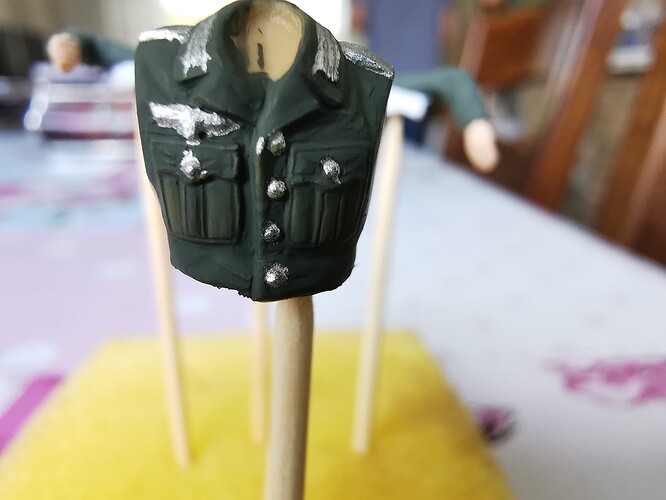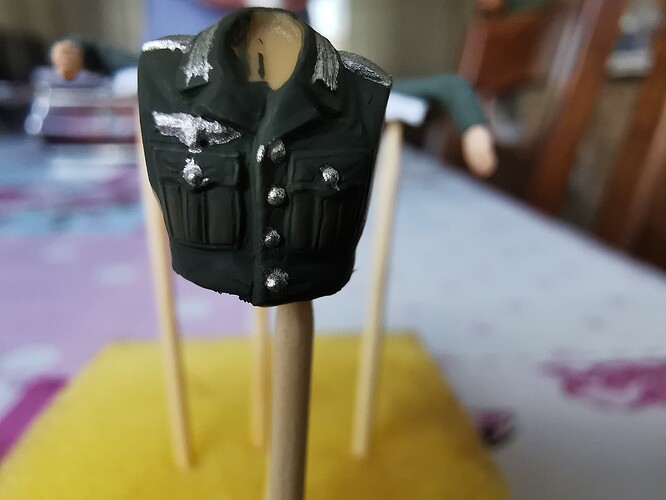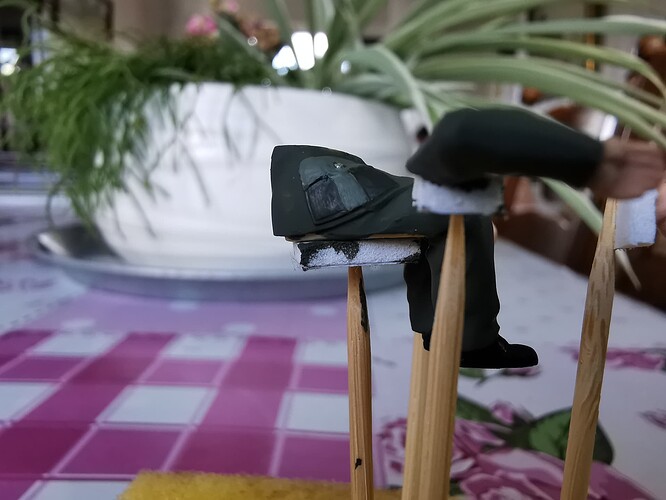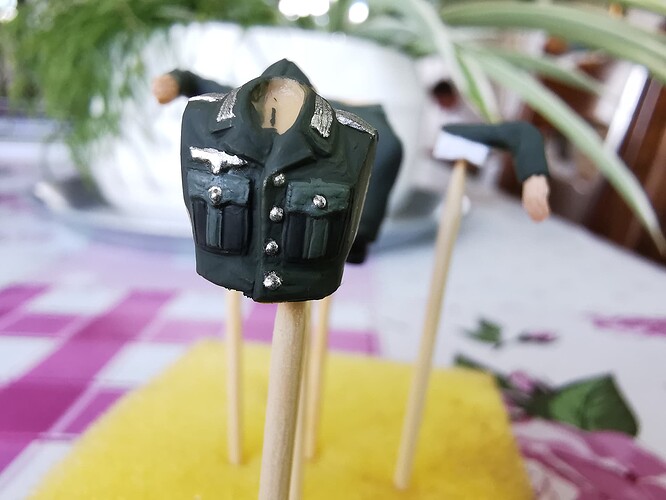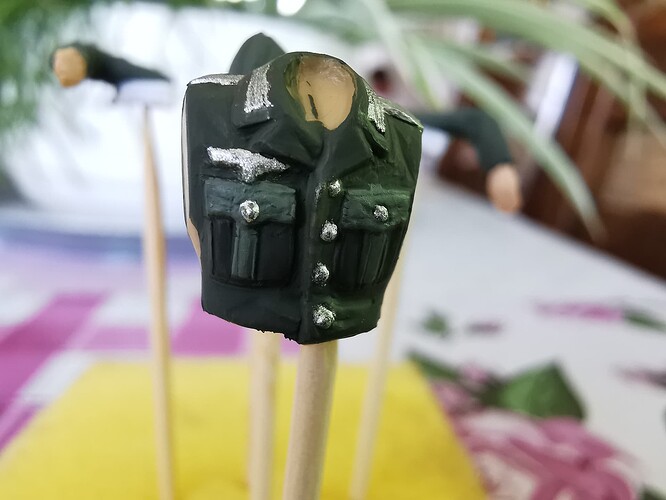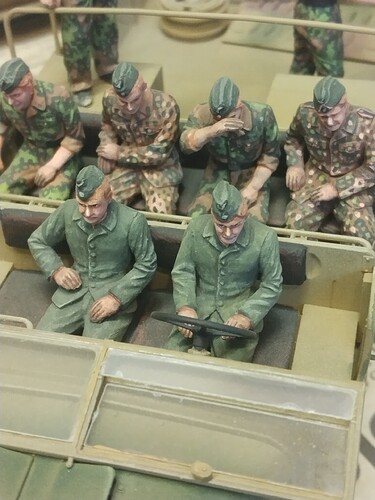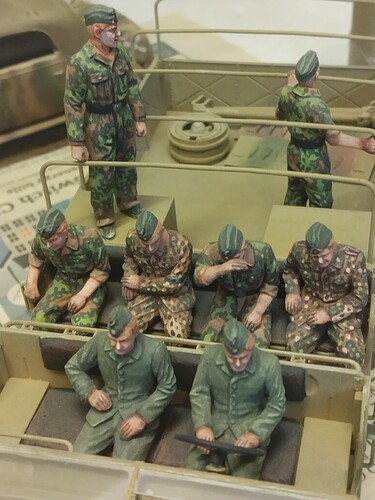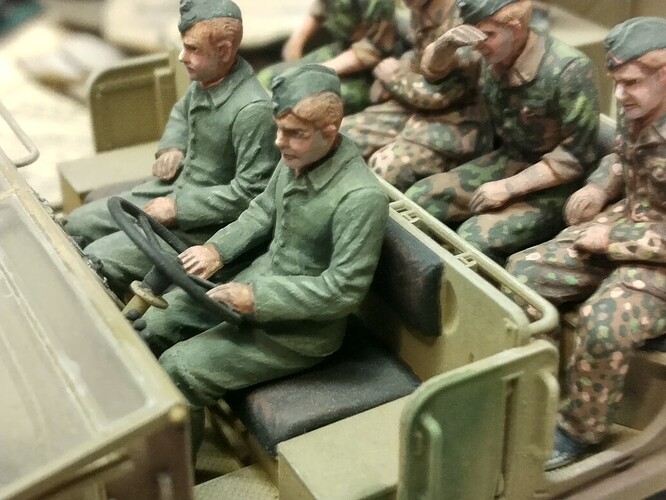I’m getting the last finishing touches on this figure of my Famo project. And since I saw the area with the pockets needed some improvement as well. I wondered, what can I do to make the pockets stand more out on this figure? I’m currently painting with Tamiya acrylic paint only. I’m having some Revell email and enamel colors remaining. Which I want to use up and replace with Tamiya acrylic colors. And that’s it. Hope you can help me.
I think we need to see the figure to really help. If it’s one of the standard figures that come with the kit, Tamiya goofed there with the uniforms. They are described in the kit instructions as Denim Uniform, in fact they are depicted wearing the Reed Green Summer Uniform, which was of denim style material, but was usually an infantryman’s light weight uniform. The Denim Working Uniform was a simpler item entirely and far more appropriate to men working with oily equipment. Originally it was a plain jacket, with slash pockets in the skirt only, not the elaborate patch pockets on chest and skirts with similar shapeless trousers in a cement coloured cloth, which appears white in wartime photos, usually pretty filthy! It was popular with engineers or pionere (who frequently wore the white trousers with the field jacket) and mechanics. Later it was issued dyed green and was the basis for the Waffen SS “pea” 1944 type pattern camouflaged suit.
Forgot the photo’s ![]()
If you mean how to make them stand out from a painting perspective then the thing I would do is add highlights and shadows. Highlights should go on any raised bits that would catch the light more than those surrounding it. So for this it would be either side of the button, the outlines and the middle parts of the main pocket. Then to add a darker color to those bits at the edges of the pocket and under the flap. The shadows and highlight should be darker and lighter tones of your base-color. Finally, if you wish to go a step further you can thin some paint to the consistency of a wash and apply it to the outline of the pocket and around the button.
(I must say though I am not sure how all this will work with Tamiya paint as it does not behave like a traditional acrylic.)
Here’s my first try at highlights and shadows. I’m feeling the shadow color is to dark. But gone ahead and used it anyway. Because it is my first time ever in my entire life I’m trying this. And I couldn’t expect this to be perfect first try.
For the highlight color. I used mixture of Tamiya Flat Base and X-2 white. Because I didn’t had the flat version of the white color. And I first want to use up what I have as much as possible. And then added the XF-65 Field Grey color until I thought. Let’s try this out and see how it turns out.
The highlight color was the hardest one to make. But it turned out okay for a first time. Still a lot of improvements to make. But the starting has been done.
Yes you have done it quite well for a first time. But as you noticed your shadow is too dark and also your highlight is too light! But don’t worry- this is a common mistake even for a modeller with experience. One trick to avoiding this is to break your shadow and highlighting into two stages each. The 1st Highlight and 1st Shadow colors should not be too different from your base color. Paint the 1st highlight and shadow on a broad area of the detail you are picking out. Then your 2nd Shadow and Highlight should be darker again than your first and applied a little more sparingly over the areas already picked out in your 1st Shadow and Highlight.
I will look into the subject, thanks for replying.
I use Humbrol, so my methods may not be applicable to your chosen medium, but here goes. I usually start with the nominal colour, say in this case Field Grey. I usually mix it myself, as the colour doesn’t really exist as a standard colour, it can range from a slate grey to a sort of fawn colour, so a bit of mismatch amongst figures is good. I then us a thin wash of say, olive green to fill all the creases and detail. When this is absolutely dry, I then highlight with the base colour with white added. This will make the shading too stark, so when the highlights are dry, I then go over with a very thin coat of base colour to blend it all in. It’s not dissimilar to how I paint vehicles, but it works for me. If there are then any area of deep shadow that need picking out, e.g. open pockets, once again a thin brush with thinned dark green. I finish of with a very light dry brush of lightened colour to make things like buttons “pop”. BTW, your badges are too bright in silver. You really need to do them in a dull lightish grey, especially for a field uniform. German buttons were moulded with a pebbled surface to retain the field grey paint, so should not be bright silver. Better to just highlight them with a lightened base colour.
Here’s some I did a while ago using the method above. They are SS, so the badges and positioning will be different, but you get the idea. Note the difference in badges and brightness between the staff officers and field officers and other ranks. The figure with the pistol is a “Spiess” or sergeant-major with the cuff rings of this appointment.


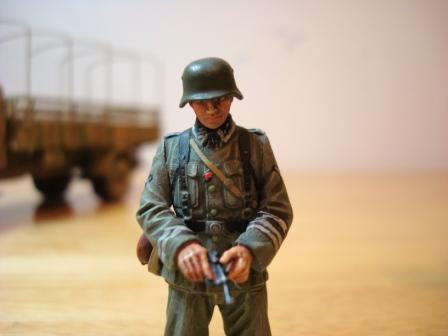
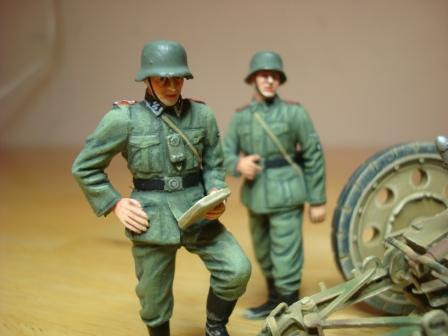
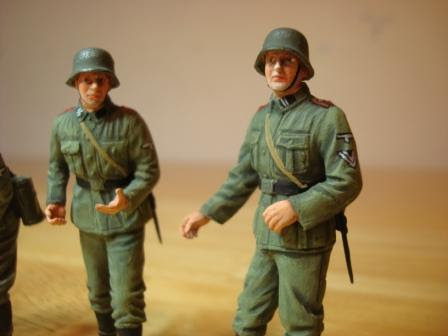
Your results look brilliant, I can learn a lot from them for sure. I’m going to keep notes on my phone. Because there are coming a lot of things I want to do really quickly. But, I’m excited to learn and try out new stuff. I’m really rediscovering the fun of the hobby.
Just for interest, here are the half track crew from my FAMO. Once again they are SS, so need clarification. The two guys in front are wearing the working dress I’ve tried to describe in my first answer, later war suits were died reed green. I shaved all the pockets off the figures. There are two more modified figures in the second row; these have had the jacket skirts removed so they look as though they are wearing camouflaged overalls. These were an SS issue it and very popular with tank and armoured car crews and assorted bods who could obtain them. Overalls in other colours, field grey, black or even civvie items were commonly worn by Heer soldiers. The other two are wearing the standard 1944 pattern SS camouflaged suit, so not really any use to you. The two standing guys were moulded wearing overalls, so I just painted them camouflaged rather than grey. Incidentally, Tamiya for some perverse reason, over crewed the half track. The crew of a recovery half track consisted of three men, driver/mechanic, commander/mechanic (usually an NCO) and mechanic (this member steered the trailer. Of course, there were enough seats for the recovered tank crew, which is why I used all of them. Members of tank regiments who weren’t actual tank crew wore standard field grey, but with pink piping, which is why the men aren’t wearing black sidecaps, but looking at them again, I should have painted five of them black to represent the tank crew!
Thanks for the kind comment. If you want to see really well painted figures, you can do a lot worse than look up Jerry Rutman’s models here: Operation “Epsom” details - Armor/AFV / Dioramas - KitMaker Network . He is excellent. I can’t take any credit for “inventing” my system, it has been learned over a long period of time and is based on the models of Sid Horton, one of the “old masters” of modelling.
Lots of information and examples I can learn from.
Brush painting with Tamiya colors are not easy. I use Vallejo and experimenting with Scale75 colors myself. Different techniques with those paints then with Tamiya paints. I am told you can add water to help make them more brush able. Can also try Mr Leveler thinner as a test. Adding in a retarder might help with drying times and painting.
For more research, check out the figure campaign.
HTH
Agree. I’ve relegated all of my tamiya and real colors to airbrush work, except for maybe the tiniest of details.
I also use exclusively Vallejo for brush painting. While I haven’t done a figure in forever, I love Vallejo for brush work. As @Tank_1812 says, a drop of water or Vallejo retarder and they lay down super smooth.
The best part about Vallejo? They remain flexible while they cure, which means small mistakes can be cleaned up with a tooth pick
Lots of information to think about. Currently, I’m wanting to use most what I have up for my model making hobby. Also because I’m wanting to do some money saving in preperation for the future to learn myself good money habits. I will take all this in time. Thanks for providing everything.
Thank you I’ll check it out when home and on my tablet.
